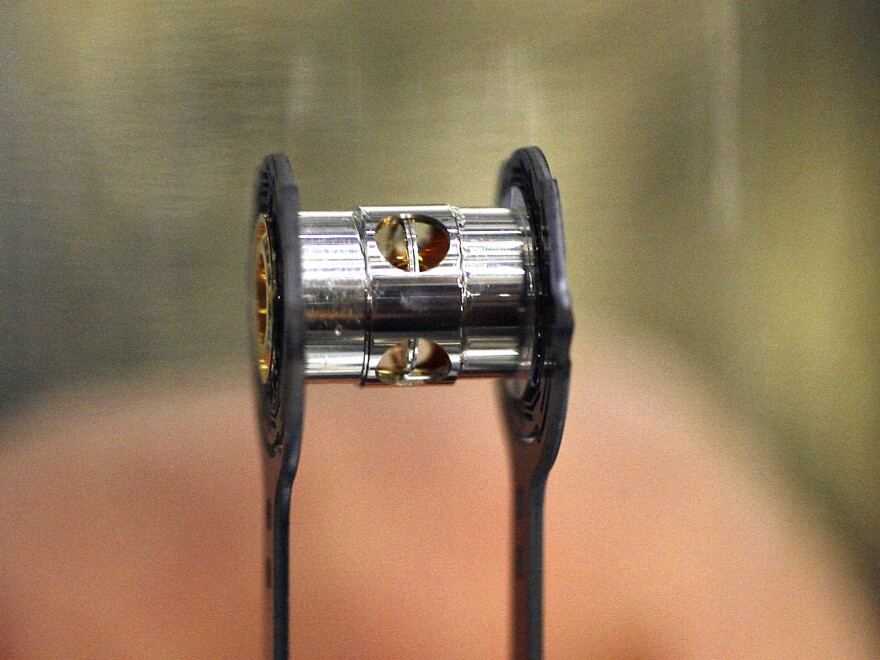The National Ignition Facility in Livermore, Calif., has been called a modern-day moonshot, a project of "revolutionary science," and "the mother of all boondoggles."
NIF, as it's called, is a $5 billion, taxpayer-funded superlaser project whose goal is to create nuclear fusion — basically a tiny star inside a laboratory. But so far, that hasn't happened.
At first glance, NIF sounds like something out of a comic book from the 1950s. But NIF director Ed Moses disagrees slightly, saying in 2008: "I think we're working on something far more far out, and far cooler than anything in science fiction or fantasy."
The idea behind NIF is to direct a laser the size of a football field — 192 lasers, actually — at one tiny capsule the size of a peppercorn filled with hydrogen. It would create degrees of heat and pressure never before achieved in a lab.

"We will raise the temperature of the target to a hundred million degrees," Moses said. "That's higher temperature and more pressure than exists at the center of our sun."
That's so hot that the hydrogen atoms would enter into a state of controlled nuclear fusion. This is not nuclear fission, where energy is generated by splitting atoms — that happens every day in nuclear power plants. It's the opposite — fusion — smashing them together.
And it's important to realize this concept, controlled nuclear fusion, is one of the most fabled dreams in science, something that has eluded generations of physicists.
So when NIF opened, there was a lot of excitement.
"I cannot wait for this to become a reality here," said California's then-Gov. Arnold Schwarzenegger, who was at NIF's dedication in 2009. George Miller, then the head of Lawrence Livermore National Laboratory, where NIF is based, was there too. Everyone seemed to believe ignition — that moment the fusion chain reaction begins — was right around the corner.
"I think we will get ignition," Miller said. "I think we'll get ignition relatively shortly after we turn the facility on."
Now, fast forward 3 1/2 years.
"We just haven't gotten it to burn yet," Moses said last month. He has been doing a lot of these interviews lately, because Oct. 1 was a deadline, set by the agency that oversees NIF — the National Nuclear Security Administration — for the project to have achieved fusion. But they just can't get the conditions right.
And Moses doesn't put too much stock in deadlines.
"We never guaranteed anything on any date," he says. "And people have to sort of get used to that. That's what great science is."
Nevertheless, the project's top brass now has some explaining to do. This month, Energy Secretary Steven Chu is required to tell Congress why NIF hasn't met its goal, despite costing taxpayers more than $5 billion so far.
For Christopher Paine, director of the nuclear program at the Natural Resources Defense Council, it'll be a giant "I told you so" moment.
"This project has gone on a long time," he says. "Billions have been invested. But to what end?"
Why, in other words, are we doing this?
It turns out there are three answers to that question, which were highlighted by a promotional video from NIF in 2009.
Reason No. 1: Clean energy.
Nuclear fusion, like fission, creates energy. But it's much more powerful and can run on hydrogen, which leaves no radioactive waste.
This could mean virtually unlimited clean energy. It's a big reason scientists have been chasing the fusion dream for so long. But critics say even if NIF works, we'd still be decades away from plugging its technology into the grid.
Reason No. 2: Global security and weapons testing.
This, actually, is the primary intent of NIF, and it has to do with the fact that actual nuclear bomb tests are banned worldwide. With NIF, you could get around that, by testing nuclear reactions inside its tiny pellet.
Reason No. 3: To "advance our understanding of the universe."
This basic research piece is the goal NIF director Ed Moses is really emphasizing these days. He points to the search for a famous subatomic particle.
"You know the Higgs Boson was just discovered at the LHC in CERN, right?" At a cost, he notes, of $10 billion. "Was it late? Was it early? Was it on time?"
The answer, he says: Who cares? This is the stuff of Grand Challenge Science, and you can't put a timeline on it.
"It's not Grand Challenge Science if you know the answer before you start," he says, "and this is exactly that."
That's the case NIF's advocates will have to make to Congress this month, and it's worked so far. After all, NIF has something for everyone: Democrats like clean energy; Republicans like weapons security.
Copyright 2020 NPR. To see more, visit https://www.npr.org. 9(MDA1MjI2NzUxMDEyNzQyMTY5MjQ2YzkwNA004))


